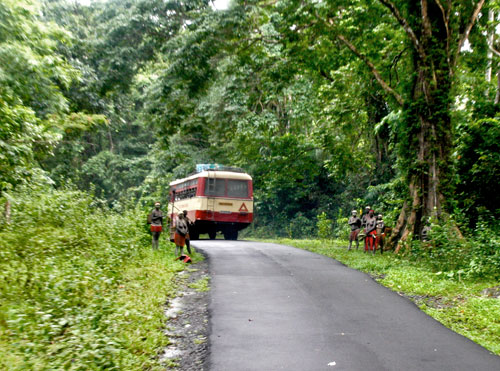|
|
The South
Asian Life & Times - SALT |
|
|||
|
Contents Adventure
Art
-
Dongria Kondh
|
|
||||
|
Jarawas
Hundreds of tourists travel daily along the Andaman
Trunk Road which runs through the Jarawa reserve, hoping to spot a member of
the 400-strong Jarawa tribe, whose ancestors are thought to have been part
of the first human migration out of Africa. The high level of intrusion
severely disrupts the Jarawa way of life as hundreds of ogling tourists pass
through their land every day. Two years ago, the world was shocked by an
international exposé of Jarawa women being forced to dance in exchange for
food. The ‘human safaris’ have been condemned by the
United Nations and India’s Minister for Tribal Affairs, who called them
‘disgraceful’ and ‘an embarrassment.’ In July 2012, the Supreme Court of India ordered the
Andaman authorities to implement a Buffer Zone to protect the Jarawa from
exploitation by tourists. The Court explicitly ordered two tourist
attractions – a limestone cave and a ‘mud volcano’ – to close. But tourists
continued to travel along the Andaman Trunk Road to visit the attractions,
and the human safari continued. In January 2013 the Supreme Court of India
banned tourists from travelling along the road which cuts through the Jarawa
reserve. By March 2013, however, the Supreme Court had reversed this interim
order – the Andaman Trunk Road was reopened to tourists to visit the
limestone cave, but photography of Jarawas and giving them food was
prohibited. Survival has been
campaigning for many years for the closure of the road that passes through
the Jarawa reserve. It first alerted the world, in 2010, that tour operators
were treating the Jarawa like animals in a zoo.
There was a call for tourists to boycott
the road. Just weeks after Survival launched a tourism boycott of the
Andaman Islands to stop the degrading ‘human safaris’ to the Jarawa tribe,
several travel companies joined the boycott and over six thousand people
pledged not to visit the islands until the tours were stopped, following
worldwide media coverage. The Supreme Court had first ordered the local
administration to close the road in 2002, but it had continued to remain
open. But despite the Supreme Court ruling of January
2013, which temporarily stopped tourists from travelling along the road, the
Andaman administration is reluctant to provide tourists and locals with an
alternative sea route, and has kept the road open to tourists.
|
|||||
|
Copyright © 2000 - 2014 [the-south-asian.com]. Intellectual Property. All rights reserved. |
|||||
